 |
 |
 |
| |
Impact of high baseline resistance to approved protease inhibitors (and fosamprenavir) on darunavir/r virologic response in treatment-experienced patients in POWER 1, 2 and 3
|
| |
| |
Reported by Jules Levin
16th Intl HIV Drug Resistance Workshop, June 12-16, 2007, Barbados, West Indies
De Meyer S,1 Picchio G,2 Vangeneugden T,1 Spinosa-Guzman S,1 Lathouwers E,1 de Béthune M-P1
1Tibotec BVBA, Mechelen, Belgium; 2Tibotec Inc., Yardley, PA, USA
AUTHOR CONCLUSIONS:
The use of any of the approved PIs at screening had no or minimal impact on the
virologic response to DRV/r in treatment-experienced patients in the POWER 1, 2 and 3 studies.
High baseline resistance to (f)APV (predicted FC >11.4) had a larger relative impact on virologic response as compared with the other PIs.
A high level of correlation in phenotypic susceptibility among all the PIs studied was observed between DRV and (f)APV
-- however, for any given level of (f)APV phenotypic susceptibility, DRV on average exhibited lower FC values than those for (f)APV, which further illustrates the high genetic barrier exhibited by DRV
-- this may explain why 31% of patients receiving DRV/r 600/100mg bid in POWER 1, 2 and 3 with high levels of resistance to (f)APV still achieved VL <50 copies/mL at Week 48.
Previous use of, or baseline resistance to, one of the approved PIs are not suitable parameters for selection of the use of DRV/r.
Selection of DRV/r use should be based on the viral susceptibility of the patient isolate.
INTRODUCTION
Darunavir (DRV; TMC114) is a new HIV protease inhibitor (PI), with potent activity against both wild-type and drug-resistant strains.1 It is co-administered with low-dose ritonavir (DRV/r) at a dose of 600/100mg twice daily (bid) in antiretroviral treatment-experienced HIV-1-infected adult patients.2,3
The present analysis evaluated the influence of PIs in patients with high baseline resistance to a PI, and in patients who were using a PI in their failing regimen at screening, on the virologic response to DRV/r in patients who initiated treatment with the 600/100mg bid dose in the POWER 1, 2 and 3 trials.
METHODS
Predicted and measured fold change in 50% effective concentration (EC50) values (FC) at baseline to all currently approved PIs (atazanavir [ATV], [fos]amprenavir [(f)APV], indinavir [IDV], lopinavir [LPV], nelfinavir [NFV], saquinavir [SQV] and tipranavir [TPV]) were determined using the virtual phenotype linear-model method (vircoTYPE, Virco BVBA, Belgium) and the Antivirogram® assay (Virco), respectively
- information was available for 449 patients using the vircoTYPE and for 438 patients using the Antivirogram assay.
High resistance to a PI was defined as having a predicted FC above the vircoTYPE clinical cut-off 2 (CCO2) using the most recent vircoTYPE (version 4.1.00), corresponding with a prediction of a minimal response to that PI
- this version provided new cut-offs for ATV/r (32.9 vs 2.5, which was the biological cut-off for ATV) and (f)APV/r (11.4 vs 9.6, which was the CCO2 for APV/r)
- the CCO2s used for the other PIs were 40.1 for IDV/r, 56.1 for LPV/r, 7.3 for NFV, 26.5 for SQV/r and 5.4 for TPV/r.
Virologic response was measured by the mean change in log10 viral load (VL) (noncompleter= failure [NC=F] analysis) over time to Week 48 and the proportion of patients achieving VL <50 copies/mL (time-to-loss of virologic response [TLOVR] analysis) at Weeks 24 and 48, according to the following criteria
-- use of individual PIs at screening
-- baseline predicted FC >CCO2
-- use of individual PIs at screening with baseline predicted FC >CCO2.
For (f)APV, which is structurally-related to DRV, the virologic response in the subgroups with baseline predicted FC >CCO2 and
The relationship in terms of phenotypic susceptibility between DRV and each approved PI was also studied using linear regression analysis (piecewise linear regression analysis for DRV versus [f]APV).
RESULTS
In the overall population of POWER 1, 2 and 3 at Week 48, patients who initiated
treatment with DRV/r 600/100mg bid had a mean change in VL of -1.65 log10 copies/mL. VL <50 copies/mL was achieved by 45% of patients receiving DRV/r 600/100mg bid.
The mean changes in VL over time to Week 48 for patients using individual PIs at screening, with baseline predicted FC >CCO2, or using individual PIs at screening with baseline predicted FC >CCO2 are presented in Figure 1 (graphs for IDV and NFV are not presented due to the low number of patients in some of the subgroups).
The proportion of patients achieving VL <50 copies/mL at Weeks 24 and 48 for those using individual PIs at screening, with baseline predicted FC >CCO2, or using individual PIs at screening with baseline predicted FC >CCO2 are presented in Table 1.
Figure 1. Mean VL reduction from baseline (NC=F) over time to Week 48 with DRV/r for patients using individual PIs at screening, with baseline predicted FC >CCO2, or using individual PIs at screening with baseline predicted FC >CCO2 for a) ATV, b) (f)APV, c) LPV, d) SQV and e) TPV.
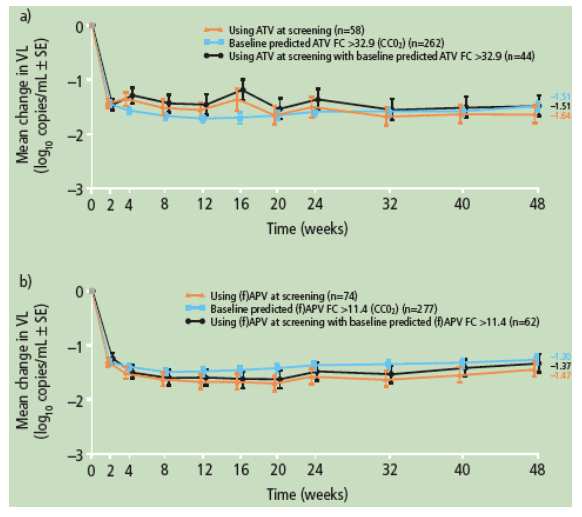
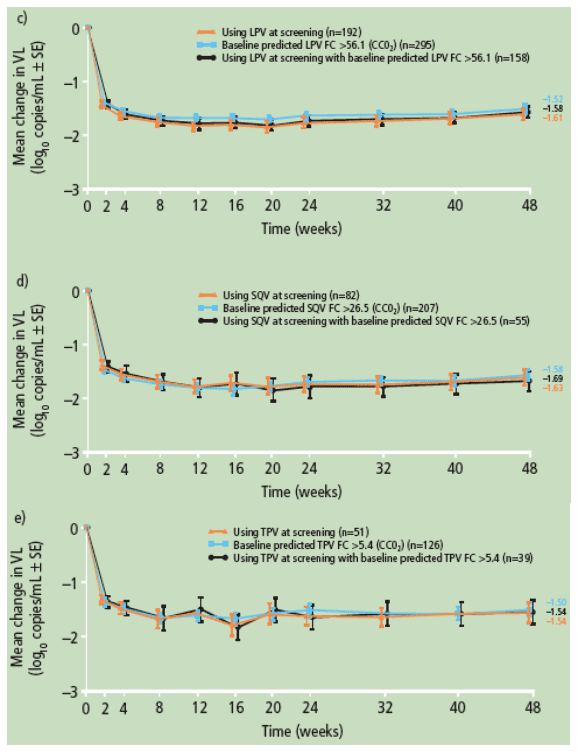
Table 1. Proportions of patients reaching VL <50 copies/mL (TLOVR) at Weeks 24 and 48 with DRV/r for patients using individual PIs at screening, with baseline predicted FC >CCO2, or using individual PIs at screening with baseline predicted FC >CCO2.
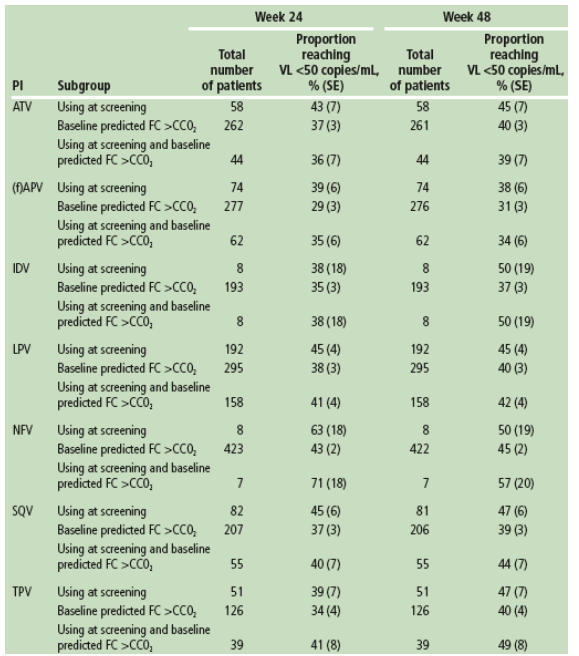
SE = standard error
CCO2s: ATV/r = 32.9; (f)APV/r = 11.4; IDV/r = 40.1; LPV/r = 56.1; NFV = 7.3;
SQV/r = 26.5; TPV/r = 5.4.
Phenotypic susceptibility relationship between DRV and other PIs
The highest correlation in phenotypic susceptibility was observed between DRV and (f)APV, regardless of the phenotype test that was used (Table 2).
Table 2. Correlation coefficients for FC values for DRV and other FDA-approved PIs.
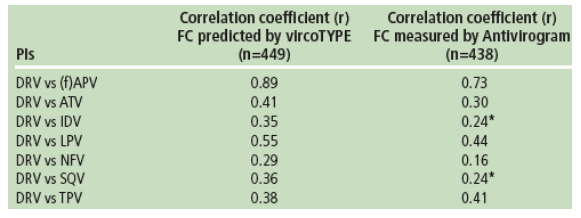
A scatter plot was constructed to study the relationship between the predicted FC to DRV and to (f)APV (Figure 2), in terms of virologic response (VL <50 copies/mL; TLOVR) at Week 48.
Table 3 shows the virologic response at Week 48 with DRV/r for patients who had baseline predicted (f)APV FC >11.4 (CCO2) or
Figure 2. A scatter plot between predicted DRV and (f)APV FC values.
CCOs (vircoTYPE v4.1.00) for DRV/r and (f)APV/r are represented by solid blue horizontal and vertical lines. The Antivirogram low CCO for DRV (CCO1=10.0)4 is shown as reference (dotted white horizontal line). The proportion of samples in each susceptibility quadrant is shown in blue. The purple line represents the bisector. FC is presented on a log scale.
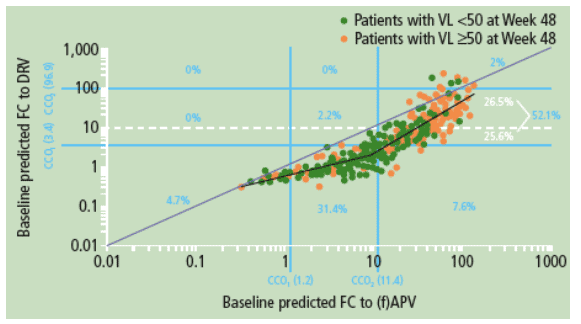
Table 3. DRV/r virologic response and estimated response using a multivariate model at Week 48 in patients with baseline predicted (f)APV FC >11.4 (CCO2) or
*Least square (LS) means and estimated percentage responses were derived respectively from an ANCOVA model and logistic regression model, including baseline log10 VL, baseline DRV FC, baseline CD4 cell count, number of susceptible NRTIs, baseline number of primary PI mutations, use of enfuvirtide and duration of HIV infection.

|
| |
|
 |
 |
|
|